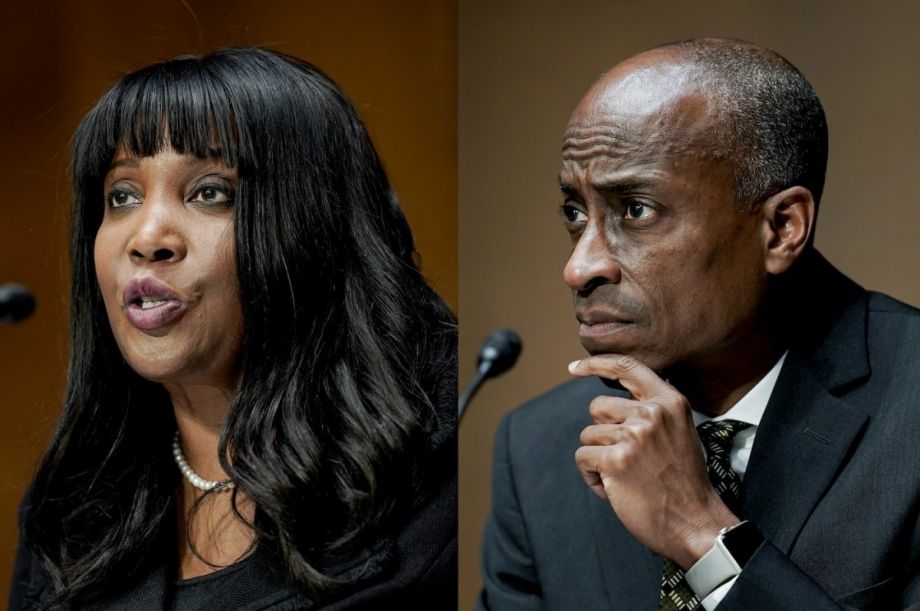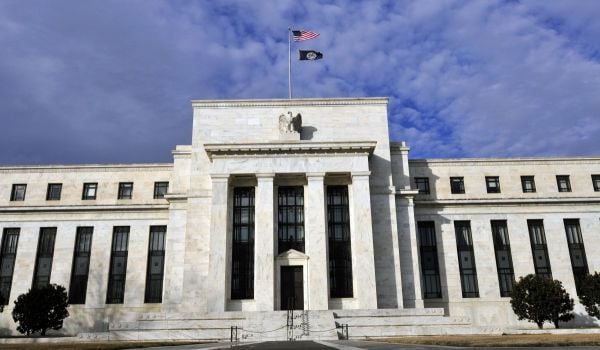It’s hard to say for sure, and the overall situation could definitely be better, but there are signs that something in the economy right now is actually working for Black communities.
In April, the Black unemployment rate fell for a fourth straight month, dropping to 5.9% from 6.2% the month before. White unemployment stayed level at 3.2%, meaning the gap between white and Black unemployment narrowed. It’s consistent with previous periods of economic growth — Black unemployment is almost always roughly twice that of white unemployment, and as both fall, the gap narrows.
Of course there’s still the Black-white wage gap, unchanged over the past 40 years, even as educational attainment gaps have narrowed. But perhaps some of that gap can be explained through the labor market. Economists believe the longer unemployment rates are below a certain threshold, say 5%, the more bargaining power workers have as employers compete to buy their labor. Looking back at unemployment rates by race, white workers spend most of the time below 5% unemployment, while Black workers spend most of the time at 7% or higher. Whenever Black unemployment falls below 7%, the next recession seems to hit.
That means Black workers never really experience the same level of bargaining power as white workers. It contributes to the Black-white wage gap, though it’s hard to say how much.
“The hotter the labor market, definitely the better for communities of color,” says Michelle Holder, labor economist and president of the Washington Center for Equitable Growth, a think tank. “A tight labor market isn’t the answer to everything, but I do believe it is a requirement to begin to move the needle on what ills affect the economic status of Black and brown communities.”
Of course, with inflation currently at the highest levels in 40 years, wage gains anywhere are mostly being erased. Many observers are looking to the Federal Reserve to raise interest rates as a way to slow down those price gains, Holder included. But how much should the Fed raise interest rates when it meets every six weeks to make a decision about it? How often and how many times should it raise interest rates over the next year or two? And most importantly to Holder, can the Fed raise interest rates without undermining the robust labor market conditions that have long been so elusive for Black communities?
Who better to help the Fed answer those questions than not one but two highly qualified individuals who come from Black communities — after four months of heated debate, this month the U.S. Senate confirmed Lisa Cook as the first Black woman and Philip Jefferson as the fourth Black man to serve on the Federal Reserve Board of Governors. It’s the first time there’s more than one Black person serving on the Fed’s Board of Governors, according to research from Kaleb Nygaard at the Yale Program on Financial Stability.
It’s “absolutely a moment of real celebration among the Black economist community in this country,” says Holder, who is Black. “They understand intimately the Black American condition. I think it’s so important when decisions are being made at the highest level of the Fed, to have someone at the highest level who has the lived experience of what these policies really mean for everyday women, everyday people of color.”
Racial justice activists also have much to celebrate, according to Vasudha Desikan. As political director at the Action Center on Race and the Economy, Desikan helped organize a campaign in support of naming Cook and Jefferson to the Federal Reserve Board of Governors along with Sarah Bloom Raskin, who later withdrew her name from nomination after bitter opposition from Republicans in Congress.
“People like Lisa Cook and Philip Jefferson are game-changing because of their identities as well as the work they’ve done that brought them to the Board of Governors of the first place,” Desikan says.
Jefferson impressed Desikan and her colleagues with his work on poverty and the racial wealth gap, “and how economists need to help solve for these issues,” she says. A former research assistant at the Fed, Jefferson has spent much of his career talking with Fed economists and serving in advisory roles to various parts of the central bank. In a 2018 interview with the Minneapolis Fed, Jefferson said the Fed “has not paid as much attention to the disparate effects of monetary policy across different demographic groups.”
Jefferson’s input contributed to the Fed’s landmark shift in 2020, adopting a framework for monetary policy that accounted for differences in economic conditions across demographic groups. Prior to that shift, generations of Federal Reserve leaders insisted on a colorblind approach to making decisions on interest rates and other policies.
Cook similarly impressed with her track record of research and public service. She’s well-known among economists for her research on how the negative impact of racial or gender discrimination hurts not only the targets of discrimination, but also the economy as a whole. Over the last few decades, economists have come to agree that new ideas, technology or business models are one of the main drivers of long-run economic growth. But Cook’s research has argued that racial and gender discrimination limits who gets to introduce new ideas into the broader economy, thus holding back long-run economic growth from its full potential.
On the public service side, Cook served as a member of the Council of Economic Advisers under President Barack Obama, as a board member at the Federal Reserve Bank of Chicago, and through other visiting appointments at the Federal Reserve Banks of New York, Philadelphia and Minneapolis.
Desikan sees Cook as the type of ally that racial justice groups have never really had at the Fed. In addition to interest rate decisions, the Fed in the coming months and years will be weighing in on many other issues of interest to Desikan, including community reinvestment and other banking regulations, finance and climate change, and cryptocurrency.
“This is someone who is going to be able to talk about what all of this means to Black and brown workers, to minority depository institutions, to civil rights groups and racial justice groups that for so long have been gatekeeped out of the Federal Reserve and policymaking at that highest level because we don’t fit the bill in so many different kinds of ways,” Desikan says.
It’s a long time coming, given it was civil rights icon Coretta Scott King’s influence in the 1970s that led to the Fed prioritizing high employment rates along with stable prices.”
“I don’t think a lot of people who really talk about the Fed understand that the [employment focus] was something that was achieved by activists and by people in the civil rights movement,” Holder says. “That push to make this part of what the Fed does has everything to do with what was happening in Black communities prior to the 60s and in the 60s and 70s.”
Cook and Jefferson are a great start, but the Fed could benefit even more if it brought more economists of color on staff. Including the Board of Governors in D.C. and the 12 regional reserve banks, just 14 out of 945 economists working across the Federal Reserve system are Black, according to data released publicly from the Fed for the first time last Thursday. Looking just at the Federal Reserve’s Board of Governors in D.C., just one of the 429 economists on staff are Black.
But on this front, it turns out Cook has already been working on it.
Back in 2017, Fanta Traore was living in South Africa, working for an education nonprofit, about to turn her back on a profession she’s now helping to transform. She had applied for and gotten accepted into the American Economics Association’s Summer Training Program. Since 1974, the program has sought to increase diversity in the field of economics. But after much consternation, Traore declined the offer initially.
But then she got a call from Cook, then serving as the Summer Training Program’s director. She called again the next day, and the day after that. They bonded over having both gone to historically-Black colleges and universities — Cook to Spelman, Traore to Howard. They bonded over having spent time studying at Cheikh Anta Diop University in Dakar, Senegal. They talked at length about the distinct lack of other Black women like them in the economics profession overall and how that lack contributes to poor policy decisions by some of the world’s most powerful economic institutions.
Traore changed her mind. She went on to do the Summer Training Program, which put her in position to later serve as a senior research assistant at the Federal Reserve Board of Governors. It also led to a connection with later program alumna Anna Gifty Opoku-Agyeman, with whom Traore founded the Sadie Collective, an organization of Black women and girls in economics that now has around 1,300 members.
“She called me for a week straight,” Traore says. “I just felt like I could see myself within her. If it were not for her, I would not have done the American Economic Association summer program, and I would have not ended up at the Fed. I would not have created the Sadie Collective.”
In addition to Cook and Jefferson, Traore is also excited by the appointment of Susan Collins as president of the Federal Reserve Bank of Boston — the first Black woman appointed to any regional reserve bank presidency. Traore believes the visibility of these recent appointments across the Federal Reserve system will help draw and keep more Black people — especially Black women — into the still-predominantly white, male field of economics. But she’s also aware of the emotional burnout that can happen easily for Black women who rise to the top levels of predominantly white institutions, and she’s been building Sadie Collective to help cope with that.
“It will mean a lot for folks to see them in these leadership positions,” Traore says. “And I also recognize that often a burden is put on Black women when they are in these spaces, who end up doing a lot of diversity, equity and inclusion work for free. And that’s because it’s really important for us to see this shift, and we want to see this shift, but it’s really on the institutions to stay committed. So I’m glad to see that these transitions are happening.”
This article is part of The Bottom Line, a series exploring scalable solutions for problems related to affordability, inclusive economic growth and access to capital. Click here to subscribe to our Bottom Line newsletter.

Oscar is Next City's senior economic justice correspondent. He previously served as Next City’s editor from 2018-2019, and was a Next City Equitable Cities Fellow from 2015-2016. Since 2011, Oscar has covered community development finance, community banking, impact investing, economic development, housing and more for media outlets such as Shelterforce, B Magazine, Impact Alpha and Fast Company.
Follow Oscar .(JavaScript must be enabled to view this email address)
















